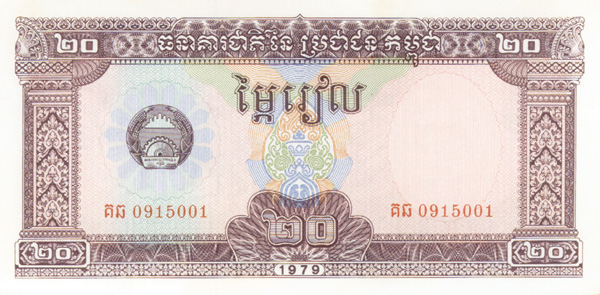Cambodia - 20 Riels - P-31a - 1979 dated Foreign Paper Money
Inv# FM1049 Paper Money Cat# P-31a
Foreign Paper Money. Arms/Water buffalo hauling logs. Pick-31a.
The riel is the currency of Cambodia. There have been two distinct riel, the first issued between 1953 and May 1975. Between 1975 and 1980 the country had no monetary system. A second currency, also named "riel", has been issued since 20 March 1980. Since the 1990s citizens have used the riel alongside the U.S. dollar at the well-known rate of 4,000 KHR/USD for retail payments.
Popular belief suggests that the name of the currency comes from the Mekong river fish, the ri?l ("small fish" in Khmer). It is more likely that the name derives from the high silver content Spanish-American dollar whose value is eight reales, a coin widely used for international trade in Asia and the Americas from the 16th to 19th centuries.
In rural areas the riel is used for virtually all purchases, large and small. However, the United States dollar is also used, particularly in urban Cambodia and tourist areas. In areas near the Thai border, the Thai baht is also accepted.
Dollarization started in the 1980s and continued to the early 90s when the United Nations contributed humanitarian aid, refugees began sending remittances home, and inflation as high as 177% per year eroded confidence in the riel. From 1991-1993, the United Nations Transitional Authority in Cambodia stationed 22,000 personnel throughout Cambodia, whose spending represented a large part of the Cambodian economy.
While the riel remains in common use in the provinces, the major cities and tourist areas heavily use the U.S. dollar. The latter is dispensed in ATMs, accepted in virtually all purchases, and USD quotations are required to price hotel rooms, airline tickets and significant financial transactions. Everyone knows the exchange rate of 4,000 KHR/US$ for retail trade, with riel paid out for change in fractions of a dollar.
In June 2020, the National Bank of Cambodia announced the phaseout from wide circulation of small U.S. dollar banknotes of $1, $2 and $5. This is aimed at reducing the cost of keeping the smaller US notes in circulation, as well as increasing the use of the riel in lieu of these notes. No fees were to be charged to collect these small notes before 31 August, 2020, but after that date banks were expected to incur costs of transporting these notes.
The piastre was introduced in French Indochina in 1885 at par with the Spanish-American silver dollar, and was in use until 1952.
In 1953, the Cambodia branch of the Institut d'Émission des États du Cambodge, du Laos et du Vietnam issued notes dual denominated in piastre and riel with the riel being at par with the piastre. At the same time, the two other branches of the Institut had similar arrangements with the ??ng in South Vietnam and the kip in Laos. The piastre itself was derived from Spanish pieces of eight (pesos).
The riel was at first subdivided into 100 centimes (abbreviated to cent. on the coins) but this changed in 1959 to 100 sen (???). For the first few years, the riel and piastre circulated alongside each other. The first riel banknotes were also denominated in piastres.
- First issue, 1955–56: 1 riel, 5 riels, 10 riels, 50 riels.
- Second issue, 1956: 1 riel, 20 riels, 50 riels, 100 riels, 500 riels.
- Third issue, 1956: 100 riels, 500 riels.
- Fourth issue, 1963: 5 riels, 10 riels, 100 riels.
- Fifth issue, 1972: 100 riels*, 500 riels, 1,000 riels*, 5,000 riels*. (* Unissued.)










Ebay ID: labarre_galleries